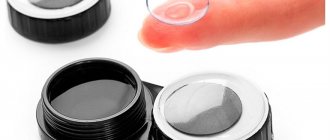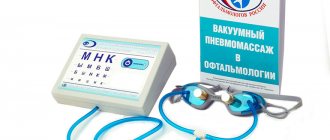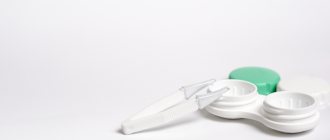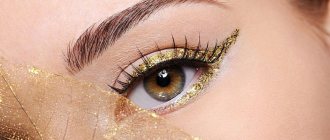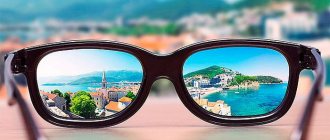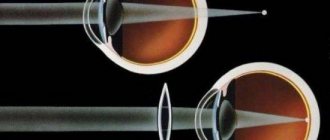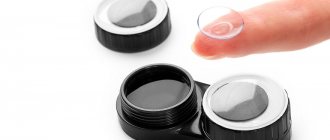Contact lenses are among the most important inventions in ophthalmology not only because they eliminate possible cosmetic discomfort from wearing glasses. More importantly, they, unlike conventional glasses, form a single optical system with the structures of the eye. With this correction, the rate of myopia progression is reduced, and in some cases a direct therapeutic effect is observed due to the location of the lens directly on the eyeball. The material and shape of the lens are such that, in terms of light refraction, it is practically no different from the natural transparent membranes of the eyeball. This helps the eye and lens work as one.
Compared to traditional glasses, contact lenses have several advantages.
- Getting used to contact lenses is much easier. They are perceived as something natural, a person almost immediately forgets about their presence in the eyes, and wearing them does not cause discomfort. This allows you to correct myopia of any degree: even with strong degrees of myopia, when glasses are practically useless (-20 diopters and above), contact lenses can correct vision by 50%, while glasses provide only one and a half to two percent correction.
- Wearing glasses for myopia causes the effect of visual reduction in the size of objects. When wearing lenses, objects appear slightly larger and the perception is more realistic.
- In cases where the degree of myopia in two eyes is different, the lenses allow you to achieve an image on the retina that is identical in size. This consistency ensures full binocular vision, which is why wearing contact lenses is used to treat and prevent strabismus and amblyopia.
- According to subjective sensations, wearing lenses provides visual perception close to natural. Patients note that the field of view, contrast and three-dimensionality of the image in the lenses are the same as without the use of optical devices.
Thus, the transition from glasses to lenses provides a new level of quality of life.
Not only for people with myopia, but also for patients with astigmatism, there are special lenses - toric; they have all the benefits of contact lenses.
It is also worth noting the possible psychological discomfort associated with wearing glasses. For some, glasses are an important and familiar element of individual style, but for others, glasses simply don’t suit them or even frankly spoil their appearance. Of course, the ability to eliminate this problem is a significant positive feature of contact lenses. Let us add that today technology allows us to produce lenses of almost any color - as they say, for every taste. Now it is possible not only to correct your vision, but also to diversify your image by changing your eye color to suit your mood.
Myopia
The projection of what is seen during myopia is displayed not on the retina, but on the plane in front of it. At the same time, a person sees well at a close distance, but distant objects have blurred contours. Constant staring leads to headaches and fatigue.
We recommend reading: Low myopia
Moderate myopia
High myopia
Myopia is characterized by 3 stages:
- Up to 3 diopters.
- From 3.25 to 6 diopters.
- From 6 diopters.
For this vision defect, optics with negative diopters are used. By using lenses at the initial stage, you can completely restore your vision.
At what age can you wear it?
There is no unanimous opinion among ophthalmologists about the age at which children can wear lenses, but most are inclined to believe that children 10 years of age can use them. It is important that the child can independently care for the lenses. Children are in some cases more particular about wearing eye devices than adults. One of the main criteria is the child’s willingness to wear them and follow the rules of hygiene.
At the age of less than 10 years, it is possible to prescribe means for correcting myopia to a child individually in each case, but difficulties may arise in observing the rules of hygiene and care.
Small children are most often prescribed one-day-old specimens, which they put on in the morning, and take off and throw away in the evening. The second option is scheduled replacement contact lenses for a period of 1 month (used much less frequently). Properly selected one-day options are considered the most comfortable and safe for the child.
Answering the question why people prefer lenses to glasses, we can confirm the fact that a person feels more comfortable and confident in them, and their vision is corrected and treated. But it is worth remembering that the patient must keep his hands clean, do not rub his eyes and use drops to moisturize.
Lens parameters
Before you start using contact lenses, you must consult with an ophthalmologist, who, during examination, will determine the degree of myopathy and examine the fundus of the eye. Lenses made of hard material and night lenses have a therapeutic effect, soft ones are used for correction. To reduce dryness of the eye mucosa, optics with a moisture content of 55% or more are used.
When selecting lenses, the radius of curvature is taken into account, which is determined by the curvature of the human cornea. As a rule, this parameter is 8.6 mm, but taking into account the individual structure of the eye, the figure can vary within 8.3 mm or 8.8 mm. If you choose the right radius of curvature, the optics will not slide across the surface of the eye when blinking or moving.
Otherwise, injuries will occur and irritation will occur.
Who is indicated for contact correction?
Indications for contact correction for myopia are divided into medical and cosmetic. Medical indications include anisometropia and aniridia in combination with myopia.
Anisometropia is a pathology in which the difference in refraction of the two eyes is more than 2 diopters. In case of anisometropia, wearing glasses is contraindicated due to the risk of developing strabismus.
Aniridia is a congenital or post-traumatic absence of part or all of the iris. The iris is a kind of filter that protects the retina from excessive exposure to light. For aniridia, special colored contact lenses are prescribed to prevent the development of retinal burns.
Cosmetic indications for contact correction arise if the patient:
- does not want to wear glasses;
- engages in active sports;
- involved in the acting profession;
Model overview
To correct myopia, they produce models that need to be changed every day, and optics for scheduled replacement with a wear period of 14 days or more. The use of CL has no age restrictions. They produce optics to improve vision in cases of myopathy with astigmatism, as well as in cases of myopia with simultaneous farsightedness.
1-Day Moist Acuvue
Daily lenses with a moisture content of 58%, acid permeability of 33.3%. The material does not cause an allergic reaction and is protected from ultraviolet rays. Price per package - from 1220 rubles.
1-Day Acuvue TruEye
Oxygen permeability - 118, moisture content - 46%. The optics are protected from ultraviolet rays and relieve fatigue when using a PC. Packaging costs 1450 rubles.
Recommended reading: 1-Day Acuvue TruEye
Proclear 1 Day Cooper Vision
It is characterized by a moisture content of 60%, an oxygen throughput of 28, and a diameter of 14.2 mm. One-day products costing from 1300 rubles.
Biotrue One Day Bausch+Lomb
One-day optics are used for myopia up to - 9 diopters. CL are characterized by protection from ultraviolet rays, high moisture content - up to 95%, oxygen permeability - 42.
In hot weather or strong winds, the mucous membrane of the eyes does not dry out. Recommended to wear if you are prone to allergies. Price per package - from 1150 rubles.
Dailies Total 1 Alcon
The lenses have almost 100% moisture content, oxygen permeability - 156. The smooth surface of the material allows you to avoid discomfort when blinking. Designed to be worn for up to 16 hours. Cost - from 1790 rubles.
Air Optix for Astigmatism Alcon
Designed to be worn for 7 days for myopia with astigmatism. The optics have protective properties against protein and lipid deposits. Oxygen permeability - 138, moisture content - 33%, lens diameter - 14.5 mm. Price - from 1090 rub.
Acuvue Oasys for Astigmatism
Used for myopia with astigmatism. The optics are characterized by a moisture content of 38% and an oxygen throughput of 129. Designed for use for 2 weeks, they must be removed during sleep.
The lenses are comfortable to wear and have protection from ultraviolet rays. Price - from 1290 rub.
Recommended reading: Acuvue Oasys
Biofinity Toric Cooper Vision
The products are used for 30 days for astigmatism; they must be removed during sleep. They are characterized by moisture content - 48%, oxygen permeability - 116. Cost - from 1660 rubles.
1-Day Acuvue Moist Multifocal
The multifocal type of optics is characterized by an oxygen throughput of 28 and a moisture content of 58%. They do not require constant care; at the end of the day they are removed or left for day 2, but then thrown away after the end of the day.
Air Optix Aqua Multifocal Alcon
Use for daily wear for 30 days. Oxygen throughput - 138, moisture content - 33%. The optics protect against lipid and protein deposits. Packaging costs 1150 rubles.
Biofinity Multifocal Cooper Vision
Lenses with a moisture content of 48% and an oxygen throughput of 160. Used for daily wear for 30 days. Packaging costs from 1820 rubles.
How to choose the right one
You should not resort to independent selection of contact lenses, since the damage caused to your own vision may be irreversible. At the initial appointment, the ophthalmologist will be able to determine the muscle tone in the eyes, measure intraocular pressure and visual acuity, and advise on how to choose lenses for correction. .
For opponents of glasses, contact lenses for myopia would be an ideal option, but there are contraindications for them:
- inflammatory processes;
- chronic eye allergies;
- xerophthalmia or dry cornea;
- glaucoma;
- change in the composition of tear fluid.
How to choose lenses to correct myopia step by step:
- To determine which lenses the patient needs, the ophthalmologist must first find out whether they have been worn before, then use a special table and a projector to check visual acuity.
- Carrying out computer diagnostics is the next step of the examination, in which an autorefractometer is used, which determines the type of pathology and stage of the disease.
- Correction of refractive balance, which may be different for the left and right eyes, so-called anisometropia.
- The study of the binocular system, the essence of which is to separate the fields of vision with lenses of different colors, polarized and green-red, will help you see close and far equally well.
- Next, you should choose eye lenses or glasses by selecting different options.
- At the last stage, the correction mode is selected.
Wearing Features
The best option for eye health is the use of daily lenses, which are contraindicated for longer wear. But their price is not affordable for everyone. Many people prefer optics with a long wear life.
Such correction products require careful care. And before each putting on, you must wash your hands with soap.
We recommend reading: How to use lenses correctly
It is strictly forbidden to sleep in any lenses, except for night ones. During the period of conjunctivitis, blepharitis and other eye diseases, you should not wear optics. When taking a diuretic, antiallergic drug and using vasodilating drops, the dryness of the skin and mucous membranes increases, so during this period it is important to use moisturizing drops.
To correct myopia, soft spherical contact lenses are used, which are selected by an ophthalmologist. It is necessary to buy products only from trusted companies and, when using them, carefully check the expiration date.
Advantages and disadvantages
Modern optics offers a huge selection of glasses and frames, but it’s not always possible to choose what really suits you. This problem will not arise with lenses, since they do not change the image, do not distort facial features and are suitable for people of any age. For myopia, the lenses provide visual acuity up to 100%.
Contact lenses for the treatment of myopia not only allow you to see clearly, but also improve peripheral vision. This is important, for example, when driving a car. Contact optics are used for both myopathy and hyperopia at the same time.
Contact optical devices are more practical than glasses in unfavorable climatic conditions (snow, rain or bright sun). They are comfortable to play sports in and do not fall off during physical activity. Contact optics allow you to change eye color; if you want to experiment with new looks, many people buy multi-colored lenses.
Main advantages:
- effective vision correction;
- no distortion;
- look aesthetically pleasing;
- wide field of view.
Disadvantages include possible dry eyes, allergic conjunctivitis, and filamentous keratitis. In addition, lenses need to be changed regularly and carefully looked after; it takes time to get used to. Read about possible causes of lens-related eye pain here.
A child with myopia should more carefully select corrective contact lenses, and children with grade 3 myopia should not wear lenses.
Consumer Reviews
Valentina: I have been using Acuvue lenses for 6 years. I give preference to one-day optics. They do not rub or cause burning.
Vasily: For 3 years I have been wearing Bausch+Lomb vision correction products. Everything is fine - the lenses breathe, are quickly put on, and the price is affordable.
Nikolay: I use daily lenses from Cooper Vision. The solution in which the products are contained does not cause irritation upon contact with the mucous membrane and is comfortable to wear. After water procedures, the mucous membrane dries out, so you have to use drops.
Rules for caring for SCL
The basic rule for using contact correction is not to exceed the period of use and wearing regimen. CL should be stored in special containers. For their cleaning and storage, universal solutions should be used. The solution in the container is replaced every time after using the lenses. An empty container is stored open, upside down. The container is changed at least once a month, preferably every time the SCL is changed. For myopia, the CL is placed on the eye and removed with clean, dry hands.
If an infection develops, used SCLs are disposed of and their reuse is not allowed.
Author of the article: Tatyana, specialist for the website glazalik.ru Share your experience and opinion in the comments.
Useful video
Lenses are effective means of vision correction. To choose the right optics, you need to take into account the purpose, rules of use, and diagnosis.
Author's rating
Author of the article
Alexandrova O.M.
Articles written
2029
about the author
Was the article helpful?
Rate the material on a five-point scale!
( 1 ratings, average: 5.00 out of 5)
If you have any questions or want to share your opinion or experience, write a comment below.
What are aspheric lenses and why are they used for myopia?
Such ophthalmic products have an internal and external surface that is elliptical rather than spherical. Lenses concentrate light rays at one point. The radius of base curvature in them increases towards the periphery. Thanks to this, the light transmission capacity at different points increases. This helps prevent light scattering too much.
Aspheric lenses have appeared on the market relatively recently. Today they have become very popular, especially for moderate and high myopia. In addition, contact optics with an aspherical design can compensate for mild astigmatism. We list the advantages of this type of optical products:
- maximum contrast image;
- wide view;
- clear vision even in twilight;
- absence of spherical aberrations.
Also, in aspherical lenses, glare from luminous objects does not bother you, and halos do not form around light sources. These disadvantages are typical for products with a spherical design.
There are also glasses with aspherical lenses. They have all the advantages of contact optics of this form. However, they have one significant “minus”. Spectacle optics do not protect against glare. It is necessary to purchase models with anti-reflective coating. This is reflected in the cost of optical products. Today, contact correction products with an aspherical design are in great demand.
What are aspheric lenses and why are they used for myopia?
Such ophthalmic products have an internal and external surface that is elliptical rather than spherical. Lenses concentrate light rays at one point. The radius of base curvature in them increases towards the periphery. Thanks to this, the light transmission capacity at different points increases. This helps prevent light scattering too much.
Aspheric lenses have appeared on the market relatively recently. Today they have become very popular, especially for moderate and high myopia. In addition, contact optics with an aspherical design can compensate for mild astigmatism. We list the advantages of this type of optical products:
- maximum contrast image;
- wide view;
- clear vision even in twilight;
- absence of spherical aberrations.
Also, in aspherical lenses, glare from luminous objects does not bother you, and halos do not form around light sources. These disadvantages are typical for products with a spherical design.
There are also glasses with aspherical lenses. They have all the advantages of contact optics of this form. However, they have one significant “minus”. Spectacle optics do not protect against glare. It is necessary to purchase models with anti-reflective coating. This is reflected in the cost of optical products. Today, contact correction products with an aspherical design are in great demand.
